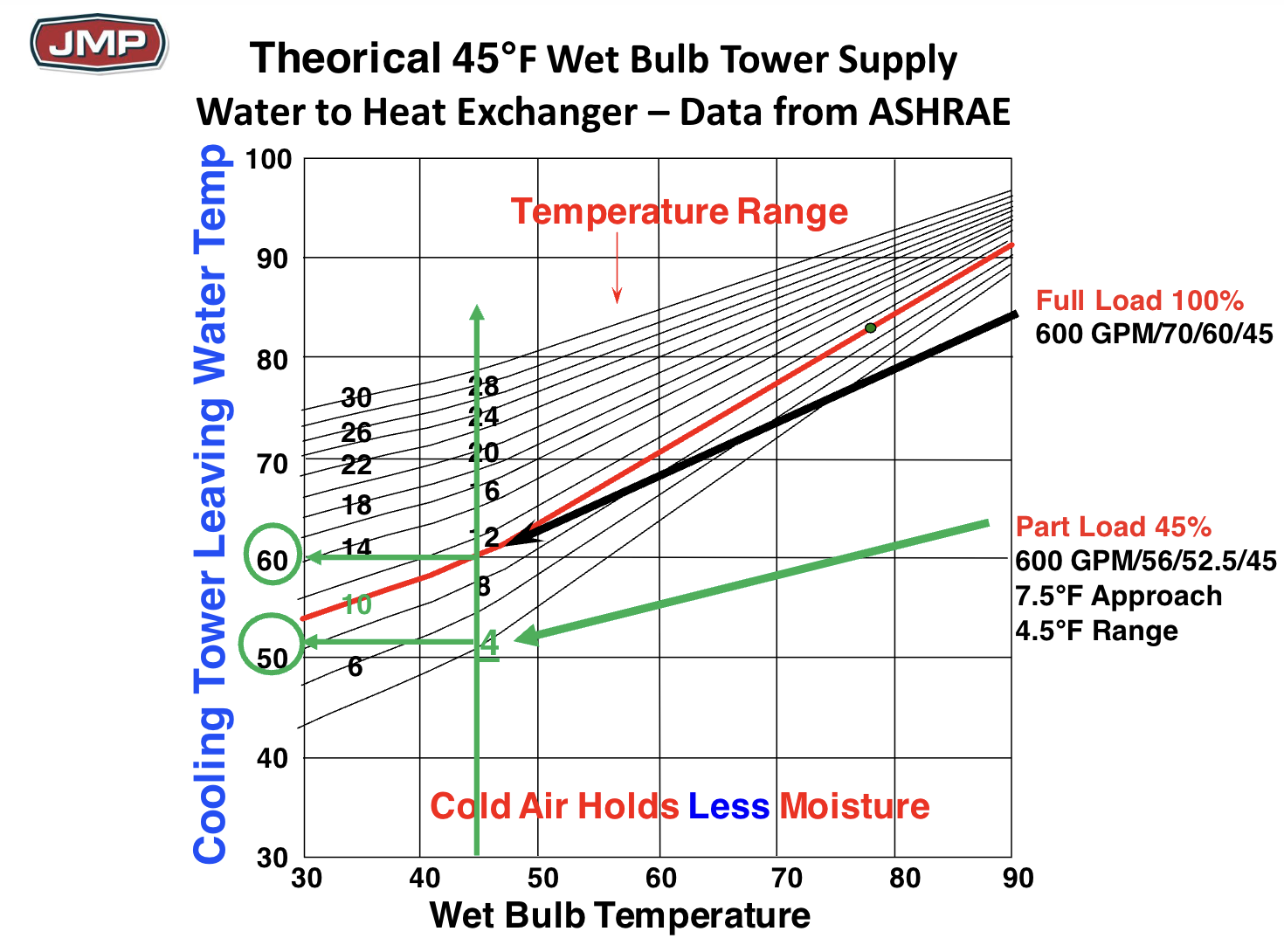
Photo credit: Brian Hobbs
Many northern state energy codes require economizers for chilled water systems. Waterside economizers per ASHRAE 90.1-2013 and 2010 shall provide up to 100% of the expected system cooling load at outdoor air temperatures of 50°F dry bulb/45°F wet bulb and below. What water temperatures might we expect from our cooling towers?
Cooling Tower Approach and Range Defined
The cooling tower accepts air blowing across return water and drops the temperature of the water. The standard of one ton of cooling is the capacity to cool 3 gallons per minute (GPM) of water from 95°F to 85°F when the outdoor air is at 78°F wet bulb. One ton is 3 X 10 X 500 = 15,000 BTUH.
Just a note: a ton of refrigeration on the chilled water side is defined as 12,000 BTUH. The difference is due to additional heat of compression that the condenser needs to reject to the tower.
To get 12,000 BTUH of heat transfer in the water, the tower must produce 15,000 BTUH. There are many articles regarding this, and I reference one below for further reading. Meanwhile, back to definitions.
Cooling tower approach is the temperature difference between the wet bulb air temperature and the cool water supplied by the tower. Using the numbers above, 85°F water supply minus 78°F air wet bulb temperature equals a 7°F approach. More about that in a minute.
Cooling tower range is the difference between the entering water temperature or return from the condenser minus the tower leaving water temperature or the supply to the condenser. Using the numbers above, 95°F water to the tower minus 85°F tower water outlet temperature equals a 10°F range.
Cooling Tower Approach and Range at 45°F Wet Bulb
We are certainly familiar with the design conditions of cooling towers. There are many reasons to use different approaches and ranges at design. There are also just as many reasons to keep the default testing numbers listed above. What happens at 45°F when state energy codes instruct us to start the waterside economizer or free cooling heat exchanger?
The ASHRAE Systems Handbook, chapter 40, shows many graphs of cooling tower approaches based on wet bulb temperature and percent of load. Our friends, another Bell & Gossett representative in the south, James M. Pleasants Co., created a composite slide which I show below.
 The graph shows the standard summer design conditions mentioned above. You may visit their blog, How To Size A Waterside Economizer Part 2: A Cooling Tower In Winter, for further review. The “X” Access is the air wet bulb, and the “Y” axis is the supply water from the tower. If we keep a constant 3 GPM per ton flow rate, and we assume the range remains 10°F, what happens as it gets colder outside? How about an example we will use when we look at lower outdoor air temperatures?
The graph shows the standard summer design conditions mentioned above. You may visit their blog, How To Size A Waterside Economizer Part 2: A Cooling Tower In Winter, for further review. The “X” Access is the air wet bulb, and the “Y” axis is the supply water from the tower. If we keep a constant 3 GPM per ton flow rate, and we assume the range remains 10°F, what happens as it gets colder outside? How about an example we will use when we look at lower outdoor air temperatures?
Example: 600 GPM X (95 minus 85) X 500 = 3,000,000 BTUH = 100% Load
Now we want to find the coldest water possible in free cooling mode at 100% load. If we slide down the 10°F range line until it intersects 45°F wet bulb, the leaving water temperature is 60°F. There is not much building cooling available with water provided to the free cooling heat exchanger at 60°F and leaving the heat exchanger at 70°F.
So, the coldest water we can get at 45°F wet bulb is 52°F degrees based on this chart. How close is this to reality? We asked one tower manufacturer to provide their data. The chart is shown below.
This data shows a supply temperature to the free cooling heat exchanger or water economizer of 45 + 5.5 = 50.5°F.
Look at the capacities I mentioned in Part One of this series, Free Cooling Heat Exchangers. Many schedules have tower water supplied at 43°F to the heat exchanger and returning at 53°F. That same schedule provides 45°F chilled water from the heat exchanger with the chilled water return at 55°F. This seems challenging.
How do we achieve a 10°F range with a very small approach? Look at the chart above. If the outdoor air is at 34°F wet bulb and the load is 50%, we could get the 43°F supply from the tower. The tower may not have a 10°F range and the tower manufacturers may start to impose some limits on temperature and flow rates. More to follow on this.
In the next R. L. Deppmann Monday Morning Minutes we will look at chilled water winter comfort loads at various supply temperatures.
PART 1: Free Cooling Heat Exchangers
PART 2: State Energy Codes
PART 4: Chilled Water Temperatures



